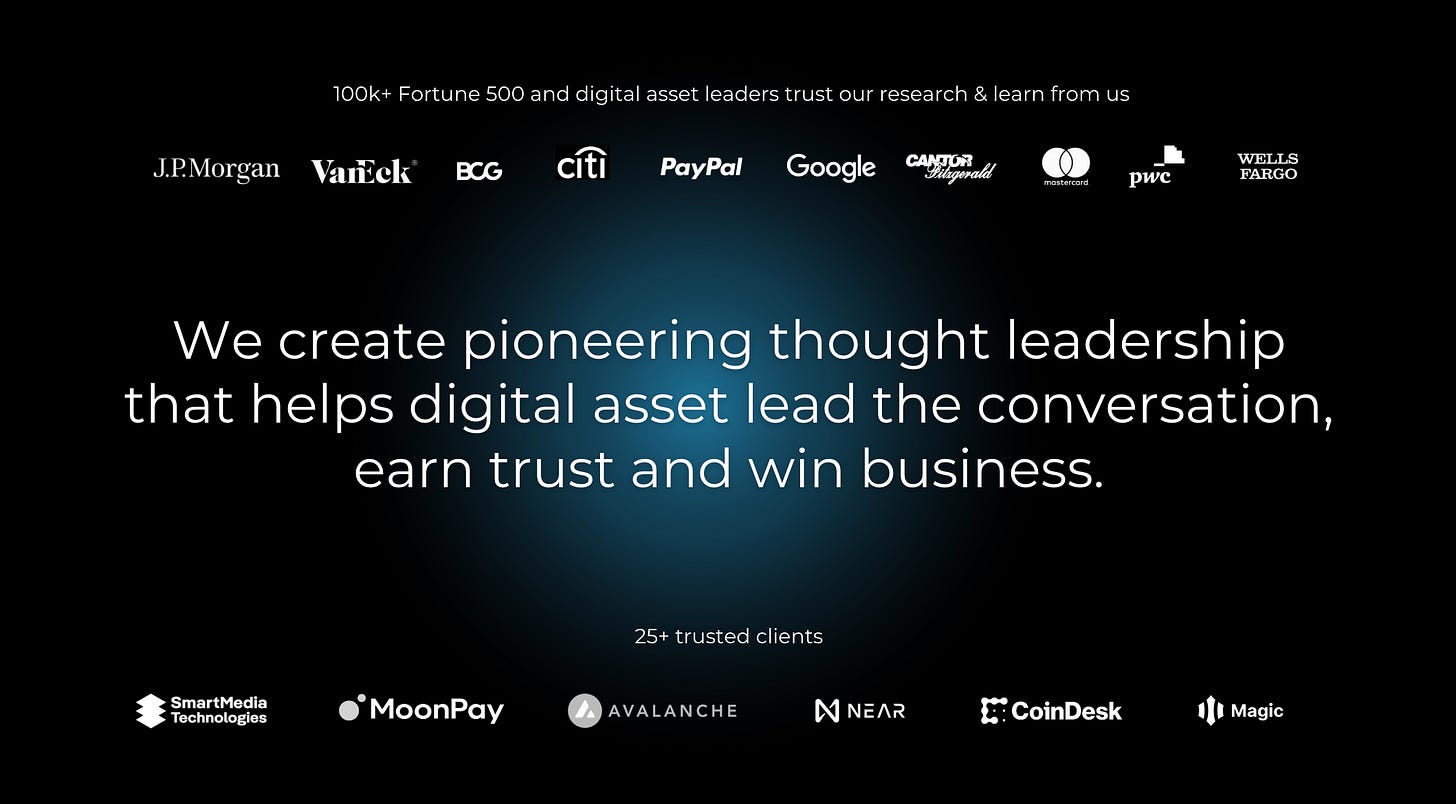Hi, it’s Marc. ✌️
“The age of accounts is ending. The age of wallets is beginning.”
— Tony McLaughlin, CEO of Ubyx, ex-Citi
For the release of our new stablecoin report “Digital Dollar, Real Yield,” we sat down with two of the sharpest operators in stablecoin infrastructure:
David Sutter, CEO of OpenTrade, powering yield infrastructure for fintechs using stablecoins
Tony McLaughlin, CEO of Ubyx and former Citi exec, building the first global clearinghouse for stablecoins
Both are quietly shaping what the next decade of global finance will look like, faster, cheaper, programmable.
Why stablecoins are breaking out
“Stablecoins didn’t come from nowhere. They’ve been 10+ years in the making.”
— David Sutter
The recent US election and the subsequent Genius Act have been a game-changer. For years, the stablecoin industry operated in a regulatory gray zone, creating significant uncertainty for businesses and investors.
“That question of will these things be illegal, or will they continue to sort of be in this gray zone, or will they actually become sort of endorsed by the Federal Reserve or the OCC? Those questions are gone now,” David explains.
This clarity means businesses can now plan for the long term, focusing on adoption and real-world use cases rather than regulatory risk.
For David, this moment is the result of a decade of infrastructure build-out:
“Emerging markets want a better, smarter, faster dollar. Fortune 500s want to move millions of payments cheaper. The crypto infra that was built over the last decade is finally meeting real-world demand.”
Exchanges, wallets, on/off ramps, and global issuers finally maturing to meet real-world demand.
Tony, who left a 30-year career at Citibank to enter the stablecoin space, sees this as a pivotal moment.
“It became clear to me that banks and fintechs would be allowed to use public infrastructure. And that for me was the catalyst.”
Stablecoins crossed $277B in market cap this year, already settling more volume annually than Visa and Mastercard combined.
For Tony, the catalyst was political:
“After the US election and the Genius Act, it became clear banks and fintechs would be allowed to use public infrastructure. That’s when stablecoins moved from gray zone to green light.”
Use case? Everything.
“If someone asks me the use case for a laptop, I tell them they’re asking the wrong question.”
— Tony McLaughlin
Both David and Tony believe stablecoins are not just a niche product but a foundational technology that will permeate every aspect of global payments.
Tony envisions a future where every type of payment on the planet leverages stablecoins. He gives a compelling example:
Imagine a major online marketplace paying its Asian suppliers in stablecoins. “The first of those marketplaces that do that transaction have the potential to be the biggest stablecoin on the planet within 18 months.”
David highlights the immense potential for individuals and small businesses in emerging markets.
“The most exciting use case is stablecoins as a global dollar account for anyone with an internet connection.”
In regions battling hyperinflation or lacking stable banking systems, stablecoins offer a lifeline: a faster, cheaper, more reliable way to save, spend, and send US dollars.
Perhaps Tony’s most provocative prediction is the end of the traditional bank account.
“The age of accounts is coming to an end because a bank account is a one-trick pony. It only contains dollars, which is a liability of your bank… A wallet can contain the liabilities of many banks and stablecoins from many issuers and tokenized money market funds and tokenized other real-world assets.”
His advice to banks and fintechs is stark:
“You must offer every one of your clients a wallet.”
This shift from single-asset, single-institution accounts to multi-asset, multi-issuer wallets represents a fundamental re-architecture of financial services.
OpenTrade: programmable yield
OpenTrade is a stablecoin infrastructure and yield platform, that enables fintechs and other financial institutions to offer stablecoin products to their customers. It provides white-labeled and fully embeddable stablecoin yield products, allowing fintechs to easily integrate them into their existing applications.
“It’s not DeFi vs TradFi. For most treasurers, it’s just: How fast does it settle? What’s the fee?”
— David Sutter
OpenTrade powers “yield as a service” — fintechs like Lydia offer users interest on dollar balances with one click. OpenTrade handles everything under the hood:
Legal + custody infrastructure
API to enable seamless yield
Vaults spanning money market funds, bonds, credit, and soon DeFi
This isn’t theoretical:
“One of our clients went from faxing money market orders to earning real-time yield through an app. That’s not 0 to 1 — that’s 1 to 10.”
Ubyx: The first stablecoin clearing house
“There are going to be thousands of stablecoins. Just like there are 16,000 card issuers today.”
— Tony McLaughlin
Tony’s team is building Ubyx, a clearinghouse for stablecoins. Think SWIFT meets Visa, but for tokenized money.
Why? FX.
“Banks and fintechs love FX. A trillion-dollar supply of USD stablecoins means $40B in annual FX revenue. Everyone will want to catch that flow.”
Ubyx solves the many-to-many mess of issuers and receivers. It gives:
A common acceptance network
Instant settlement
Non-interest income for stablecoin issuers
“Stablecoin issuers shouldn’t rely only on interest rates. That’s a fragile business model.”
Takeaways for Leaders
For business leaders looking to leverage stablecoins, both David and Tony offer clear advice:
Experience it firsthand: David urges, “Go use them.” Experiment with buying, sending, and receiving stablecoins to understand their power and current limitations.
Focus on acceptance first: Tony:
“Most companies think their stablecoin strategy starts with issuing. It doesn’t. It starts with accepting.”
This allows businesses to immediately capitalize on foreign exchange opportunities.
Think beyond current market structures: Don't extrapolate the future from today's limited stablecoin landscape. Be prepared for a pluralistic, highly competitive market with many new entrants.
Embrace the wallet era: Banks and fintechs must evolve beyond account-centric models and offer multi-asset wallets to remain relevant.
Prioritize liquidity over blockchain: While different blockchains offer varying speeds and costs, liquidity (primarily USDC and USDT today) is paramount for a transfer asset.
What happens next
“The winners haven’t even entered the arena.”
— Tony
Visa and Mastercard won’t kill themselves. But they will get disrupted.
“If stablecoins just feed into cards, we’ve failed.”
— Tony
What does success look like?
Native stablecoin acceptance
Ubiquity across wallets, PSPs, and treasuries
Frictionless cross-border payments
A true programmable money layer
“In 3 years, your wallet will do what your bank never could.”
The stablecoin revolution is about fundamentally re-imagining how money moves globally. Tune in to know more about OpenTrade, Ubyx and their strategy in the space.
📝 Get the full report
We have covered all these nuances in detail in our report co-published with Avalanche blockchain.
Take care,
Marc
More from us:
🚀 Work with us: We create pioneering thought leadership that helps digital asset and technology companies lead the conversation, earn trust and win business.














